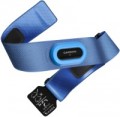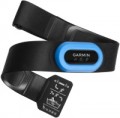Measurements and calculations that can be carried out with the device.
—
Heart rate. Heart rate measurement in real-time is a crucial feature for devices with a heart rate monitor function and is primarily the main function for
heart sensors and
pulse oximeters. In fitness, heart rate is a key parameter, aligning with various training goals such as fat burning, maintaining shape, or cardiovascular strengthening. Many models can also detect critical situations like heart rhythm disturbances or excessive heart rate, providing user warnings. However, it's important to note that not all heart rate monitors or combined devices offer continuous monitoring; some models require touching the sensor for measurements. Therefore, for constant pulse data, ensure the selected device supports continuous monitoring.
— The level of oxygen in the blood. The pulse oximeter function measures blood oxygen saturation levels using a specialized sensor in a non-invasive manner, without puncturing or damaging the skin. It's important to acknowledge that the oxygen level sensor is not a certified medical device. However, it effectively responds to critical decreases in saturation, such as those experienced by climbers at high altitudes or individuals with specific respiratory conditions.
—
Perfusion Index (PI). A parameter found exclusi
...vely in pulse oximeters (see “Type”). Perfusion Index (PI) is a measure of blood flow in the finger being measured. The PI indicator is measured as a percentage and can vary from 0.3 to 20%. A value in the range of 4 – 7% is considered normal. If you deviate from this range, the saturation measurement results may be distorted.
— Number of steps. Step count measures the number of individual steps taken by the user, aiding in achieving recommended activity levels for a healthy lifestyle, fitness, or physical therapy. The function calculates steps taken in various ways, such as recording results for multiple sessions or days, displaying total and average numbers, remembering target values, and signaling their achievement. It's important to note that not all devices with a pedometer function (refer to "Type") support step count measurements. Some devices, designed for professional sports where movement speed is crucial, may prioritize other metrics over step count.
— Distance travelled. The function measures the total distance covered by the user. Basic models calculate distance in real-time, while more advanced ones can summarize results and work with target values. There are two main measurement methods: classic pedometers determine distance by multiplying the number of steps by the set step length (refer to "Individual settings"), while models with GPS use satellite navigation data (see "Features"). The first method has a larger error, but it's often not critical. The second method is more accurate but is costlier and may not work well in areas with weak satellite signals, such as dense urban areas or indoors.
— Movement speed. Measurement of the current movement speed. Like the distance traveled, this indicator can be calculated in two ways — by the number of steps or by data from the GPS module; see above for details on both methods. The simplest measurement option provides measuring the speed only at the current time, however, additional features may be provided — for example, building a schedule for a workout.
— Energy expenditure (calories). The function measures the amount of energy expended during a workout, commonly referred to as "burned calories". Monitoring energy consumption is crucial in weight management training programs as it helps track metabolism. However, it's essential to note that modern heart rate monitors and pedometers do not directly determine actual energy consumption. Instead, they estimate the number of calories based on factors such as heart rate, movement speed, number of steps, user's personal characteristics (refer to "Individual settings"), and other indirect parameters. Despite being approximate, these calculations are generally accurate enough for practical application.
— The amount of burning fat. The function calculates the amount of burned fat during a workout, typically measured in weight units such as grams. Similar to energy consumption, the device doesn't directly measure the actual fat burned but estimates it from various auxiliary data. The accuracy of these measurements is relatively low, and this parameter is not a primary focus in fitness. However, tracking the amount of fat eliminated can serve as additional motivation for users.
— Average/maximum heart rate. Calculation of the average and maximum value of the heart rate for a certain period of time (usually for one training session). These calculations are based on general information about the heart rate; about its meaning, see above.
— Activity time. The function measures the total duration of the user's physical activity, specifically recording only the time during which the device sensors detect the activity. Breaks in sessions are excluded from the recorded time. For instance, if you walked 1000 steps in 20 minutes with a 3-minute break, the recorded activity time would be 17 minutes. This feature distinguishes it from a regular stopwatch (refer to "Features") and enables accurate tracking of the duration and intensity of training loads.
